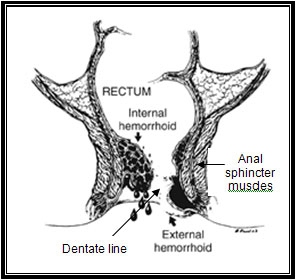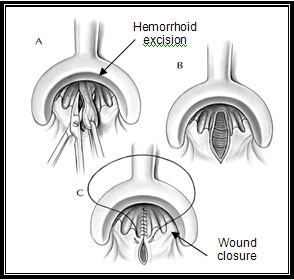Hemorrhoidectomy
[lwptoc]
Surgical Hemorrhoidectomy, The Definitive Guide!
Hemorrhoidectomy, closed or open, consists of excising hemorrhoidal tissue using a sharp instrument, such as a scalpel, scissors, electrocautery, ultrasonic thermal device, or even laser followed by complete wound closure with absorbable suture. Typically all three hemorrhoidal columns are treated at one time though the extent of the procedure depends on the particular patient’s anatomy. Postoperative care includes frequent sitz baths, analgesics/anti-inflammatory medications, and stool softeners.

Potential complications include pain, bleeding, urinary retention, fecal impaction, and very rarely, infection, anal stricture, and fecal incontinence. Although this technique has the most postoperative discomfort and pain, it does have the best long term results with the lowest recurrence rates. Other surgical and nonsurgical methods are discussed here to decrease the pain and possible complications associated with the surgery and should allow for a better patient experience.
External hemorrhoids usually develop over time and may result from straining with stools, prolonged sitting, child-birth, , constipation, or diarrhea. External hemorrhoids represent distended vascular tissue in the anal canal. You can read more about hemorrhoids by following this link to the American Society of Colon and Rectal Surgeons’ web site. You can also learn more by clicking here.
External hemorrhoids often develop in healthy young persons and may suddenly become thrombosed. Persons with thrombosed external hemorrhoids usually present with a painful anal swelling that worsens with posture or defecating. The thrombosis is slowly absorbed by the body during the course of several weeks. A resolving thrombosis may erode through the skin and cause bleeding.
Acutely swollen and tender thrombosed external hemorrhoids or chronically symptomatic hemorrhoids can be surgically removed using a procedure called hemorrhoidectomy.

When excising a thrombosed hemorrhoid in the office setting, the patient is first rolled to the left side, the right hip and knee are flexed, and a drape covers the patient’s waist and legs. After injecting the operative filed with a local anesthetic, An elliptic incision is then made over the hemorrhoidal complex and the entire diseased hemorrhoidal plexus is removed sharply. The site can be left open and should heal fairly quickly. If a more extensive procedure is required, general anesthesia is administered in an outpatient surgical center and the hemorrhoids are excised in a similar fashion. Though the wounds may be left open, most surgeons prefer to close the incisions with suture to limit postoperative pain and bleeding.
Follow-Up after Hemorrhoidectomy
The patient should have a follow-up visit at four to six weeks post procedure. Some physicians also recommend colon examination for all patients with hemorrhoids. The medical literature provides conflicting recommendations on the need for colon evaluation, but if flexible sigmoidoscopy is performed, it should occur between approximately 12 weeks after the original surgery.
The following video explains how surgical hemorrhoidectomy or classical hemorrhoid surgery is performed. Other treatment methods are explained on our website as well.
